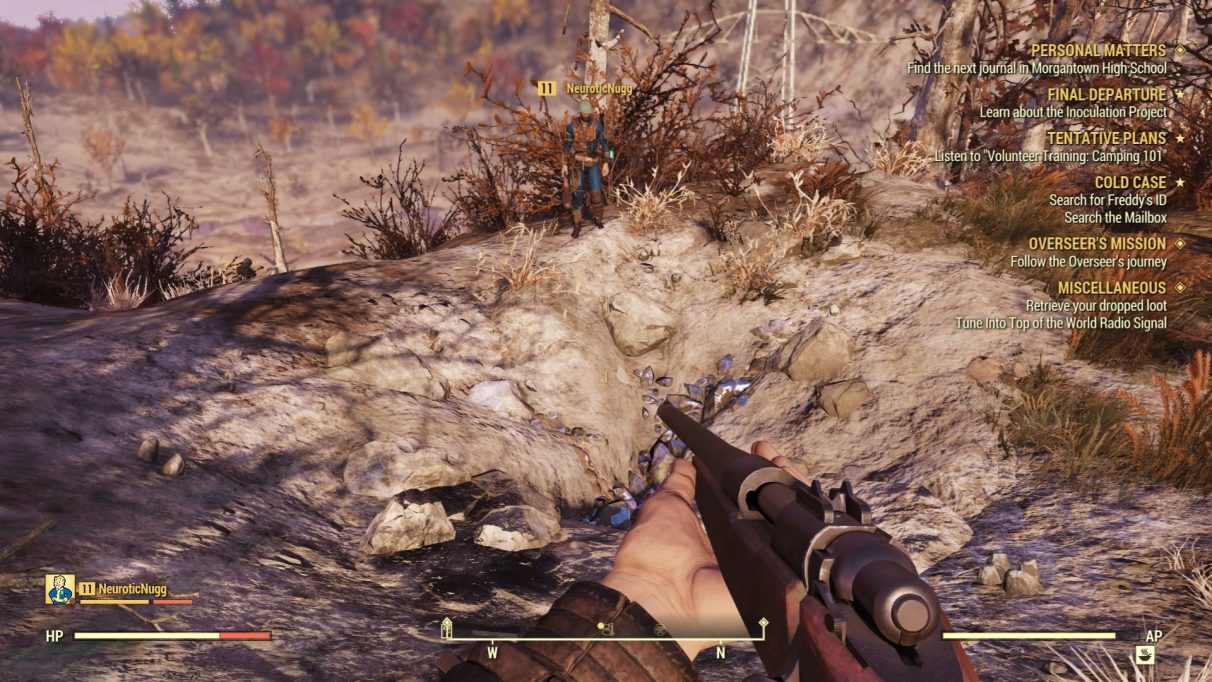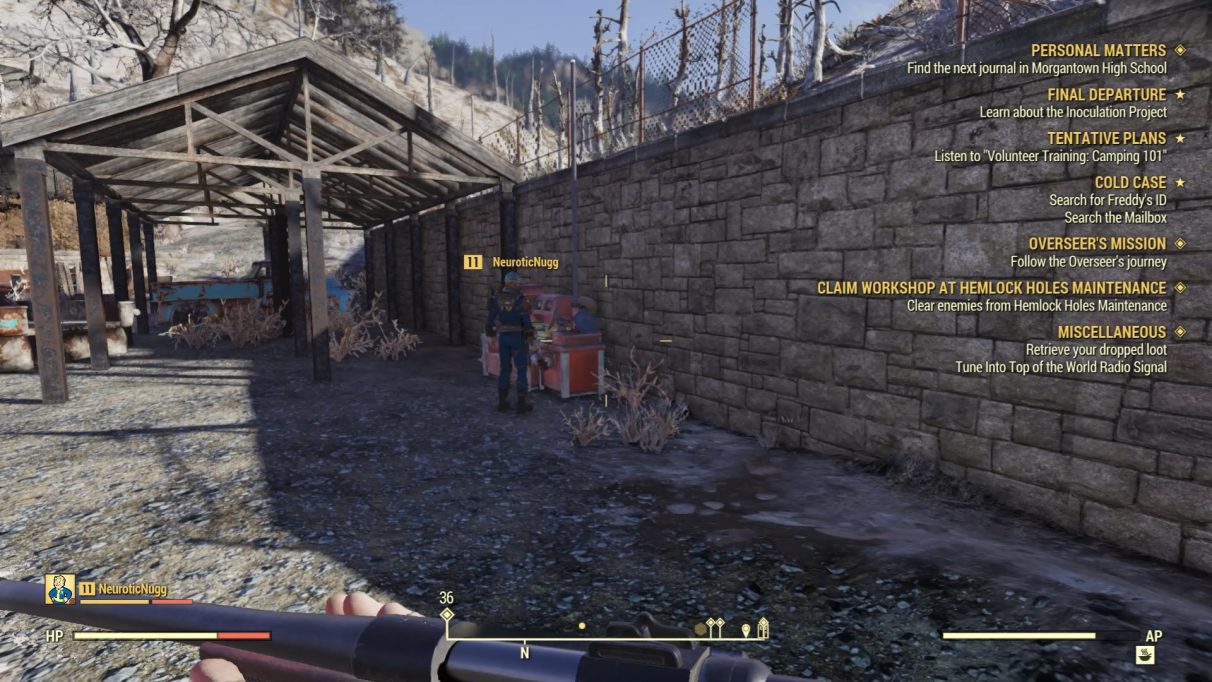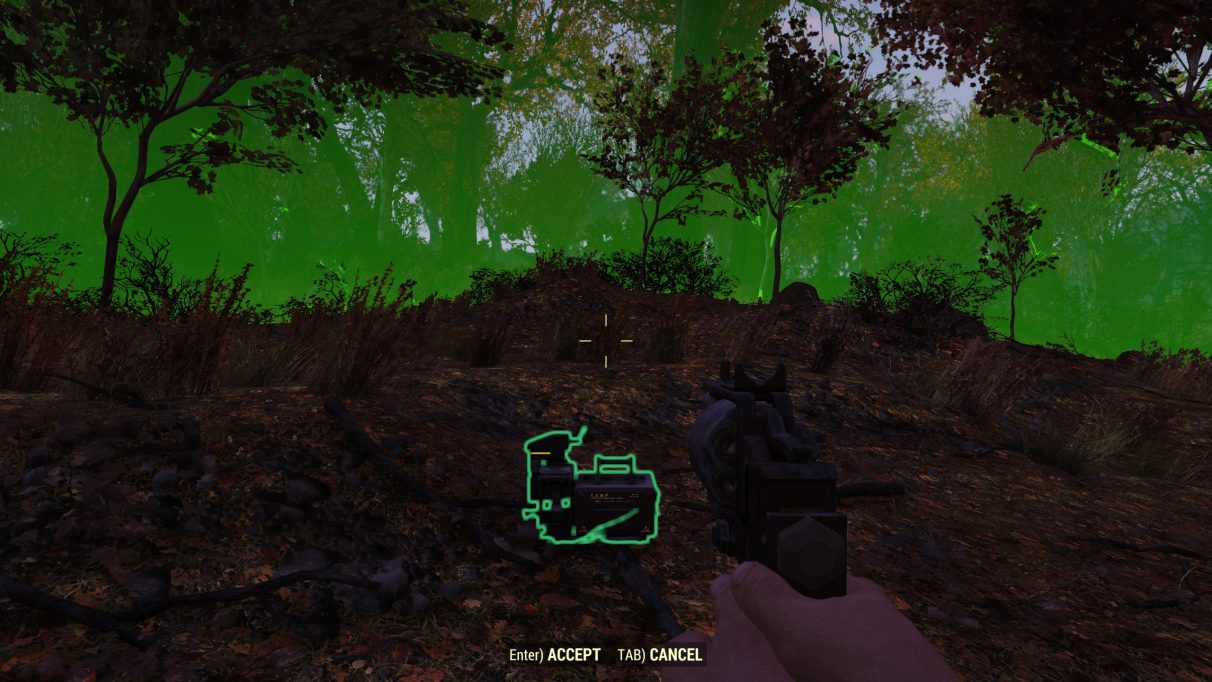Fallout 76 CAMP guide
Some locations to build your CAMP are better than others, so you may wish to move your base at short notice. This Fallout 76 CAMP guide will show you how to move your CAMP in a time of crisis, goes over all the workshop locations, and list the essential buildings you should make for your base. Those looking for a beginner’s guide to Fallout 76 should have a look at our Fallout 76 guide. Compared to Fallout 4, building stuff has a greater emphasis on crafting. As such, you will also need to defend its contents from other players and enemies alike.
Essential buildings to make in Fallout 76 How to use blueprints Managing storage Powering your facilities What are drill spots? Fallout 76 plans and recipes Gathering raw materials How to get workshops in Fallout 76 How to move your CAMP in Fallout 76 Fallout 76 guide series
Essential buildings to make in Fallout 76
To set up and move your CAMP, you need to open up the inventory and press the corresponding button on screen. You’ll then see in the game’s world a highlighted version of the CAMP which will be green if the location is a valid place to plonk your CAMP down, or red if it isn’t. You can only place it on semi-flat surfaces that are nowhere near established buildings. Once you’ve built your base, you can then build stuff around it. I’d highly recommend that you make a floor first. This acts as the foundations of your base, ensuring that your stuff can be constructed no matter where you try to place it. After making the floor, and possibly some walls, here are some other things it’s a good idea to set up:
A Vault-Tec storage box to place your stuff in. This will allow you to get rid of your junk, as well as any weapons and items you do not wish to use. A campfire to cook food gathered from enemies and harvested from the crops growing all around Appalachia. All crafting bench types to allow you to create new items, as well as repair or modify weapons and armour. Some turrets to defend your base from attackers.
In order to make anything at your CAMP, you’ll need the corresponding recipe. You get a fair few for simply starting the game, but there are some early quests that introduce you to some of the game’s concepts which reward you with more recipes. You can also make stuff by finding recipes elsewhere in the region of Appalachia. As of the Wastelanders update, there are now companions you can bring along to your base. To learn more about how to get them, you can have a look at our Fallout 76 ally guide.
How to use blueprints
Once you’ve have a building that you are happy with, you can save your construction by going into the modify menu and holding the Blueprint button. This will highlight the first piece with subsequent pieces able to be selected. There is a cap as to how many parts you can save in one blueprint, but this is a rather generous limit for small bases and you can make multiple blueprints. You do need to select every single piece in a room to save it to the blueprint. It’s worth putting down a tailored foundation to put your blueprints on as not every location is created in the same way. This may take some time, but making foundations in advance is worth it in the long run.
Managing storage
As your base of operations, your CAMP can house various different workbenches to make and repair items. However you will need somewhere to store all the scrap. The best thing to do is make yourself a storage box, however there is a huge caveat you need to be aware of: you can only store a certain amount of scrap. The storage limit has been upgraded constantly, but there have been controversies surrounding how much storage you have if you haven’t paid for the Fallout 1st subscription service. So you’ll need to be conservative with how much you’re storing, contemplating bundling up scrap with plastic to make bundles that aren’t as heavy. The storage limit is currently 800lbs, which is double the initial limit of 400lbs when the game first launched.
Powering your facilities
When making certain items for your base, you may find that you need to find a power source to run them. You’ll need to create Power Generators and connect them up to the various equipment such as drills or lights via cables. You may need to extend the reach of the cables with extenders. This requires extra resources, so make sure you grab more than you need just in case.
What are drill spots?
In certain areas of Appalachia, you may come across craters with some materials in them. You can just pick up the ores and crystals found within, but by building drills you can excavate much more resources. There are a few drawbacks. Drills are noisy devices and will attract a lot of attention from enemies and other players. Monsters will try to destroy your drills, while other players may just steal your mined materials while you’re gone. You’ll need to build sufficient defences to protect them, such as turrets. You can find the following materials in craters:
Acid Aluminum Black Titanium Coal Concrete Copper Crystal Fertilizer Gold Iron Junk Lead Oil Silver Ultracite Uranium
As for where to find those drill spots, I can’t recommend enough using the Fallout 76 interactive map from “Map Genie”.
Fallout 76 plans and recipes
Scattered throughout the region of Appalachia, there are multiple recipes and plans that allow you to make things. These range from food recipes to plans to make new facilities and defences. Their locations are mostly randomised, but the good news is that once you’ve discovered a plan or recipe, you don’t need a second copy. However, and I can’t stress this enough for newer players/those who didn’t really experiment with crafting in Fallout 4, make sure you actually go into your inventory and use the plans or recipes. You won’t learn a recipe or plan unless you read them. The game will conveniently tell you if the recipe or plan you have picked up is a duplicate. If that is the case, you can store it in your storage box or flog it to other players for a few caps. Here are some locations of some of the plans to get you started:
Gathering raw materials
Appalachia is absolutely covered in junk, so it can a good idea to invest some time into picking up random items until your inventory is maxed out. Being over-encumbered means that your AP goes down when you walk normally in a similar vein to how sprinting works. When the AP runs out, you’ll then walk really slowly, but it can be restored by standing still. Storing junk in your CAMP should be a priority as it can take up valuable inventory space. If the CAMP is not nearby, look for the nearest train station or consider dropping stuff you don’t need to free up space. So what should you keep an eye out for when looting? Wood is perhaps the most useful material you can gather and it is found everywhere in The Forest region. You’ll also find a lot of random tat in the thousands of lockers, dressers, tables, and every other storage container in the game. Then it’s just a simple case of fast-travelling back to your CAMP to scrap all the junk items at crafting tables and then storing scrap in the storage box. If you want to track which junk items in the world have the required materials, you can press the track button indicated on screen when attempting to construct an item or building facilities that you don’t have enough materials for.
How to get workshops in Fallout 76
Dotted around the land are workshops that can be taken over in order to build a separate base of operations. In order to take over a workshop, you’ll need to kill all the enemies in the local vicinity. Some will be the normal enemies in the game, but you may find you also need to deal with other players vying for control of the workshop. Once you’ve done so, you can spend around 25 caps to begin the takeover process. You’ll need to stay in the area to take it over, but once you’ve done so, you’ll be able to build on the land the same way you’ll build a CAMP. One thing that should definitely be taken into account is that everything that is build with workshops doesn’t use your own personal stash of resources. Instead there is more of a collective pool of resources that can be used to make all sorts of items like crafting tables, drills for any nearby holes, and defences to protect your workshop from AI enemies and other players. Since workshops can be taken over, the stuff you make from them doesn’t impact your personal stash. Below is a list of all the workshops in the game, along with the items you’ll get to use with it. Use the search function in the table below to search by region. Any resources with an asterisk next to it require an extra side-quest to unlock or generators to power up.
How to move your CAMP in Fallout 76
Once you do place your CAMP, it will be placed on the map and will be able to be fast-travelled to for no cost. Sometimes though it may be very far from where you want to be, so you may need to relocate your camp. To counter the fact that fast-travelling to your CAMP is free, while fast-travelling almost everywhere else requires caps to fast-travel to, you will need to pay a small amount of caps to relocate it. Aside from just being inconvenient, you may find that upping sticks and moving house may be inevitable if you provoked a vindictive player with nuclear codes. Find out how to get even in our Fallout 76 nukes guide. If you used blueprints, then rebuilding your CAMP is a little easier. If you want to ensure that you have the most convenient of spots, it may be worth making a note of the best places to plonk down your CAMP in advance. Pay particular attention to any craters or other resources that you can mine nearby.
Fallout 76 guide series
These should be enough information on the Fallout 76 CAMP to get you started on making your own base. We hope you’ll check back soon as there’s the many quests that the game has throughout the ruined world of Appalachia, what each perk card does, and what you need to craft certain weapons. But for now, do check out the rest of our guides below:
Fallout 76 guide - Tips and tricks for getting started with Fallout 76. Fallout 76 server status - For all the updates regarding when Fallout 76 is online or offline, head here. Fallout 76 Bobbleheads - They’re no longer permanent. Find out more about them here. Fallout 76 Magazines - These are also no longer permanent. Locate them here. Fallout 76 challenges - Want to customise your character? Get more atoms by completing challenges. Fallout 76 diseases - New to Fallout 76 are diseases. Find out how to prevent or cure them. Fallout 76 mutations - Also new are Mutations. Some are great, others are not, so discover more about them. Fallout 76 perk cards - Perks are completely different here. Get the lowdown on how they work. Fallout 76 Power Armor locations - Want to look like a Brotherhood of Steel member? Grab a Power Armour frame. Fallout 76 event quests - A primer for all the event quests in Fallout 76. Fallout 76 daily quests - How to unlock the daily quests in Fallout 76. Fallout 76 enemies - A full list of enemies in Fallout 76 and details on variants. Fallout 76 nukes - Deliver the nuclear payload to your enemies and scavenge for rare materials. Fallout 76 lockpicking - Access safes and locked doors with ease. Fallout 76 terminal hacking - Obtain secrets and disable traps by hacking terminals. Fallout 76 character creation - Make your character as unique as possible. Fallout 76 weapons - Make weapons and discover why you should pay attention to condition. Fallout 76 armour - Craft armour and learn about outfits. Fallout 76 treasure maps - Unearth valuable treasure left behind after the bombs fell. Fallout 76 multiplayer - Join up with others to complete quests.
Fallout 76 Wasteland guides
Fallout 76 ally - How to recruit all the new allies in the Wasteland update. Fallout 76 gold bullion - How to make a fortune in gold bullion. Fallout 76 factions - Learn about the Settlers and the Raiders.



